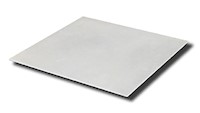| Items |

6061-T6-020-48-144
Aluminum Sheet - 6061-T6
|

6061-T6-025-48-144
Aluminum Sheet - 6061-T6
|

6061-T6-032-48-144
Aluminum Sheet - 6061-T6
|

6061-T6-040-48-144
Aluminum Sheet - 6061-T6
|

6061-T6-050-48-144
Aluminum Sheet - 6061-T6
|
|
Material
|
N/A
Aluminum
|
|
Shapeform
|
N/A
Sheets
|
|
Series
|
N/A
6061-T6
|
|
Grade
|
N/A
6061
|
|
Preparation
|
N/A
Interleaved
|
|
Temper
|
N/A
T6
|
|
Thickness
|
N/A
0.02 inches0.508 mm
|
N/A
0.025 inches0.6350 mm
|
N/A
0.032 inches0.8128 mm
|
N/A
0.040 inches1.016 mm
|
N/A
0.050 inches1.27 mm
|
|
Size
|
N/A
48 x 144
|
|
Width
|
N/A
48
|
|
Length
|
N/A
144
|
|
Sheet Weight per Unit Area
|
N/A
0.282 lbs/ft²1.376724 kg/m²
|
N/A
0.353 lbs/ft²1.723346 kg/m²
|
N/A
0.452 lbs/ft²2.206664 kg/m²
|
N/A
0.564 lbs/ft²2.753448 kg/m²
|
N/A
0.706 lbs/ft²3.446692 kg/m²
|
|
Weight per Sheet
|
N/A
13.55 lbs6.13815 kg
|
N/A
16.93 lbs7.66929 kg
|
N/A
21.68 lbs9.82104 kg
|
N/A
27.10 lbs12.2763 kg
|
N/A
33.87 lbs15.34311 kg
|
|
ASTM Specification
|
N/A
AMS 4025 AMS 4026 AMS 4027 AMS-QQ-A-250/11 ASTM SB-209
|
|
Ultimate Strength
|
N/A
45 ksi
|
|
Yield Strength
|
N/A
40 ksi
|
|
Elongation percent in 2 inches
|
N/A
12
|
|
Hardness Brinnel Number
|
N/A
95
|
|
Ultimate Shearing Strength
|
N/A
30 ksi
|
|
Fatigue Endurance Limit1
|
N/A
14 ksi
|
|
Modulus of Elasticity2
|
N/A
10.0 x 102 ksi
|
|
Resistance to Corrosion - General3
|
N/A
B
|
|
Stress Corrosion Cracking4
|
N/A
A
|
|
Workability (Cold)5
|
N/A
C
|
|
Mechinability
|
N/A
C
|
|
Brazeability6
|
N/A
A
|
|
Gas Weldability7
|
N/A
A
|
|
Arc Weldability8
|
N/A
A
|
|
Resistance Spot and Seam Weldability9
|
N/A
A
|
|
Applications
|
N/A
Heavy-duty structures requiring good corrosion resistance, truck and marine, railroad cars, furniture, pipelines
|
|
Density
|
N/A
0.098 lbs/in³
|
|
Specific Gravity
|
N/A
2.70
|


